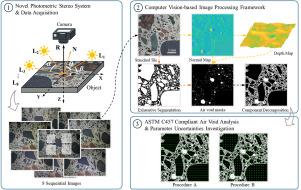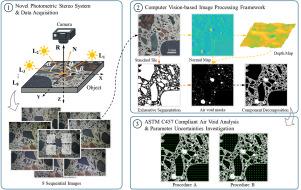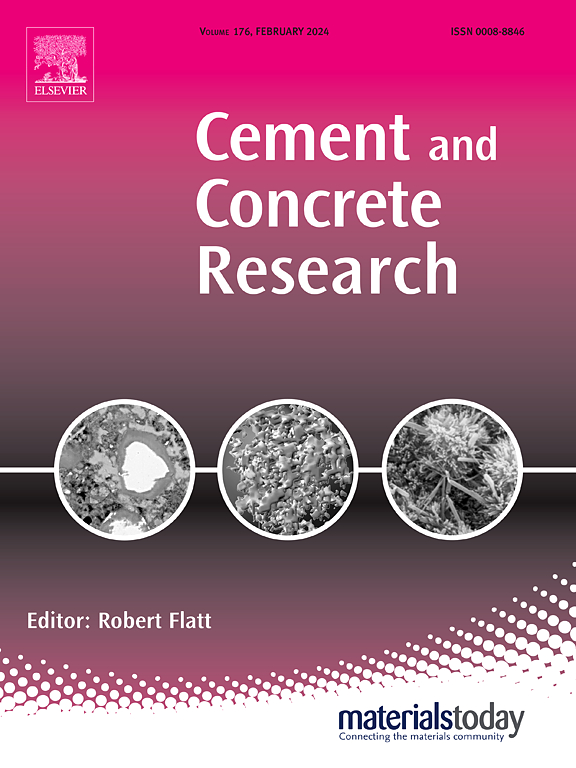A photometric stereo and Vision Transformer-based framework for automated air void analysis in hardened concrete
IF 13.1
1区 工程技术
Q1 CONSTRUCTION & BUILDING TECHNOLOGY
引用次数: 0
Abstract
Air void analysis in hardened concrete typically requires the Linear Traverse Method (Procedure A) or the Modified Point-Count Method (Procedure B), as described in ASTM C457, to assess the content and distribution of entrapped and entrained air voids. These parameters are critical for assessing freeze–thaw resistance, workability, and mechanical properties. Conventional approaches rely on manual sampling and inspection by trained technicians, which are not only time-consuming and labor-intensive but also inherently subjective due to operator-dependent interpretations. This study proposes a novel framework integrating Photometric Stereo and Vision Transformer models to automate air void analysis with enhanced speed, accuracy, and generalizability. By leveraging a newly designed photometric stereo system and a computer vision-based image processing pipeline, the proposed method addresses key limitations in existing techniques, such as the inability to detect shallow or deep voids, incomplete boundary identification, and challenges in distinguishing air voids from aggregates. The framework seamlessly integrates image acquisition, recognition, extraction, and analysis, completing the entire process within approximately 10 min, excluding initial specimen preparation. When compared to current automated petrographic analysis methods, this approach achieves state-of-the-art precision, with mean accuracies of 97.970% for air void content and 97.176% for spacing factor, while eliminating the need for surface treatments or extensive model training. Furthermore, the study reports a comprehensive sensitivity analysis of parameter selection in Procedures A and B, offering deeper insights into ASTM C457 specifications. The proposed solution significantly reduces time and labor costs associated with air void analysis, enhances result reliability, and demonstrates potential for broader applications in micro-scale 3D surface reconstruction and property evaluation.


一种基于光立体和视觉变换的硬化混凝土中空隙自动分析框架
硬化混凝土中的空隙分析通常需要ASTM C457中描述的线性导线法(程序A)或修改点计数法(程序B)来评估被困和夹带的空隙的含量和分布。这些参数对于评估抗冻融性、可加工性和机械性能至关重要。传统的方法依赖于训练有素的技术人员进行人工采样和检查,这不仅耗时费力,而且由于操作人员的解释,这本身就是主观的。本研究提出了一种新的框架,集成了光度立体和视觉转换模型,以提高速度,准确性和通用性来自动化空隙分析。通过利用新设计的光度立体系统和基于计算机视觉的图像处理管道,该方法解决了现有技术的关键局限性,例如无法检测浅孔或深孔、边界识别不完整以及在区分空气空洞和聚集物方面存在的挑战。该框架无缝集成了图像采集、识别、提取和分析,在大约10分钟内完成整个过程,不包括最初的标本制备。与目前的自动化岩石学分析方法相比,该方法达到了最先进的精度,空隙含量的平均精度为97.970%,间距因子的平均精度为97.176%,同时无需进行表面处理或大量的模型训练。此外,该研究报告了程序a和B中参数选择的全面敏感性分析,为ASTM C457规范提供了更深入的见解。该解决方案大大减少了与空隙分析相关的时间和人工成本,提高了结果的可靠性,并在微尺度3D表面重建和性能评估方面展示了更广泛的应用潜力。
本文章由计算机程序翻译,如有差异,请以英文原文为准。
求助全文
约1分钟内获得全文
求助全文
来源期刊

Cement and Concrete Research
工程技术-材料科学:综合
CiteScore
20.90
自引率
12.30%
发文量
318
审稿时长
53 days
期刊介绍:
Cement and Concrete Research is dedicated to publishing top-notch research on the materials science and engineering of cement, cement composites, mortars, concrete, and related materials incorporating cement or other mineral binders. The journal prioritizes reporting significant findings in research on the properties and performance of cementitious materials. It also covers novel experimental techniques, the latest analytical and modeling methods, examination and diagnosis of actual cement and concrete structures, and the exploration of potential improvements in materials.
 求助内容:
求助内容: 应助结果提醒方式:
应助结果提醒方式:


